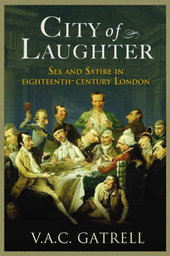
|
City of Laughter: Sex and Satire in Eighteenth-century London
Hardback
Main Details
| Title |
City of Laughter: Sex and Satire in Eighteenth-century London
|
| Authors and Contributors |
By (author) Vic Gatrell
|
| Physical Properties |
| Format:Hardback | | Pages:432 | | Dimensions(mm): Height 234,Width 156 |
|
| Category/Genre | British and Irish History
World history - c 1750 to c 1900 |
|---|
| ISBN/Barcode |
9781843543213
|
| Classifications | Dewey:942.07 |
|---|
| Audience | |
|---|
| Edition |
illustrated edition
|
| Illustrations |
fully integrated throughout
|
|
Publishing Details |
| Publisher |
Atlantic Books
|
| Imprint |
Atlantic Books
|
| Publication Date |
12 October 2006 |
| Publication Country |
United Kingdom
|
Description
James Boswell observed that a person living in eighteenth-century London, 'may be in some degree be whatever character they choose'. London was, quite simply, the most vibrant and powerful city in the world. This vivacity - famously depicted by the satirical artists Gillray, Cruikshank and Rowlandson - gave rise to lewd and iconoclastic behaviour unlike any other in English history. Gatrell's remarkable book argues that we cannot comprehend our own capacity for licentiousness or our sense of humour without understanding this unique period in English history. "City of Laughter" is as original as it is brilliantly written and will change permanently our view of London and its inhabitants.
Author Biography
VIC GATRELL is professor of British history at the University of Essex, a life fellow of Gonville and Caius College, and a member of the Cambridge history faculty. His previous book, The Hanging Tree (OUP, 1995) was published to critical acclaim and chosen by Linda Colley and Jeremy Paxman as their 'Book of the Year'.
Reviews"'A quite outstanding book, moving and perceptive... richly imaginative.' Linda Colley, Observer 'Magnificent... brilliant... luminous... penetrating.' Ian Gilmore, Guardian 'Brilliant' Richard Gott, The Times" Kirkus Review US:British author and academic Gatrell (British history/Univ. of Essex; The Hanging Tree, 1994) explores exhaustively, albeit most pleasantly, the golden age of graphic satire that flourished in licentious London from 1770 to 1830.London under George III and George IV was an economically and politically dynamic city, fast-growing, foggy and sinister, where the upper classes enjoyed enormous excesses and the lower classes writhed abjectly, with a chasm between. A new hunger for more graphic, explicit imagery was the result of an expansion of print culture and the attendant growth in demand from sophisticates as well as lower professionals and craftsmen. The older, classical tradition epitomized by the work of William Hogarth gave way to "commercial products [rooted] in the realities their purchasers recognized"-namely, politically roiling, scatological and sexually scandalous prints by artists like James Gillray, Thomas Rowlandson and George Cruikshank. The dreamscapes of William Blake and Henri Fuseli also merit attention here. The miseries of the city, the goings-on inside private clubs and the Prince of Wales's profligate behavior (and marital battles) were the favorite subjects of the era, all treated in densely informative chapters. Gatrell's reading is vast and scholarly; he moves from the diverse personalities of London neighborhoods to evolving expectations of manliness and femininity; from the nature of laughter to the different kinds of humor expressed in prints (i.e., satire, caricature, literary grotesque). He highlights some of the innovators, like Thomas Tegg, who transformed the print trade "by cutting costs and prices," and ends with the era's "silencing" by the rise of the Cant and the middle class. The pages are lavishly illustrated by prints from the period. A lively, erudite study. (Kirkus Reviews)
|